
by Ria Olivier | Sep 2, 2021 | Legacy, Marion Island, Uncategorised
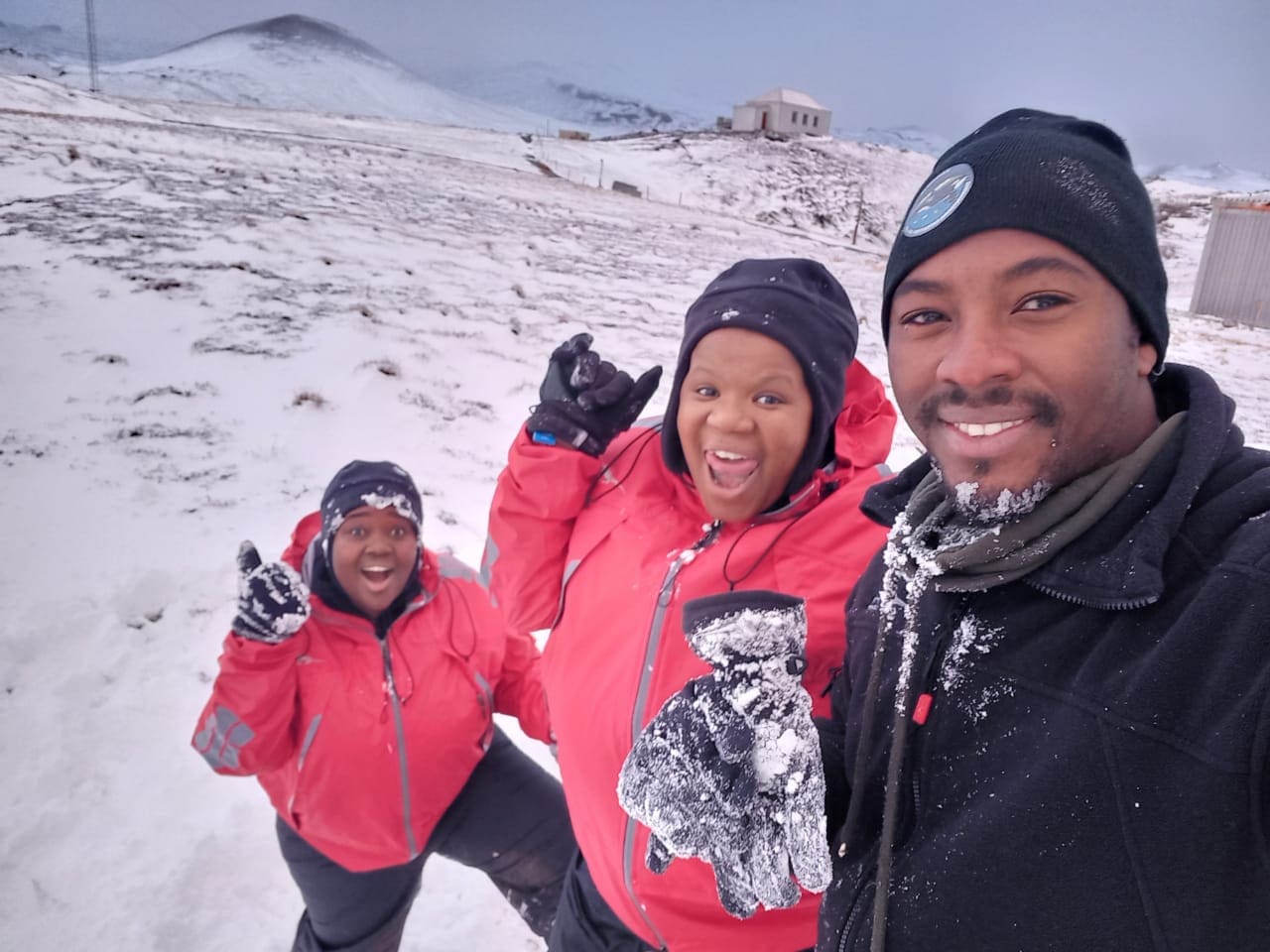 Marion 78, our Overwintering team members at Marion Island celebrate Spring 2021. (Above(l-r: Alicia Siyasanga, Tlhonolofatso)
Marion 78, our Overwintering team members at Marion Island celebrate Spring 2021. (Above(l-r: Alicia Siyasanga, Tlhonolofatso)



Our Meteorologist team of the South African Weather Services, Alicia Phakula (Meteorologist Technician), Siyasanga Mpehle (senior Meteorologist) and Tlhonolofatso Tebele (Meteorologist Technician) made some time to take these pictures on Spring day in the snow and share their experience with us.
 Danielle Conri, field assistant on killer whales of the Marion Island Marine Mammal Program of Pretoria University celebrates spring day while crossing though Marion Island to sensus seals (photo credit Wild Ocean Wanderers)
Danielle Conri, field assistant on killer whales of the Marion Island Marine Mammal Program of Pretoria University celebrates spring day while crossing though Marion Island to sensus seals (photo credit Wild Ocean Wanderers)

 Always good to make a snow angel.
Always good to make a snow angel.
Follow Wild Ocean Wanderers on Facebook to keep up to date with the Marion 78 team

by Ria Olivier | Aug 27, 2021 | Environment, Marine Protected Area, Marion Island, Mice Eradication, Research, SANAP, Science

Ecosystem processes are changing worldwide, especially with the impacts of invasive species being exacerbated by climate change.  This is particularly obvious in the Southern Ocean where a warmer and dryer environment allows the proliferation of species once limited by the cold climate. South African Special Nature Reserve, Marion Island is no exception. A recent proliferation of invasive House Mouse attacks on endangered breeding seabirds suggests a profound alteration of the natural ecosystem. This has led to the planned eradication of mice at Marion Island in winter 2023.
This is particularly obvious in the Southern Ocean where a warmer and dryer environment allows the proliferation of species once limited by the cold climate. South African Special Nature Reserve, Marion Island is no exception. A recent proliferation of invasive House Mouse attacks on endangered breeding seabirds suggests a profound alteration of the natural ecosystem. This has led to the planned eradication of mice at Marion Island in winter 2023.

 For the next three years, the new SANAP project co-led by Dr Maëlle Connan (Research Fellow in the Marine Apex Predator Research Unit, Nelson Mandela University) and Prof. Peter Ryan (director of the FitzPatrick Institute of African Ornithology – University of Cape Town) will focus on three data deficient species of avian scavengers: Black-faced Sheathbill, Kelp Gull and Brown Skua.
For the next three years, the new SANAP project co-led by Dr Maëlle Connan (Research Fellow in the Marine Apex Predator Research Unit, Nelson Mandela University) and Prof. Peter Ryan (director of the FitzPatrick Institute of African Ornithology – University of Cape Town) will focus on three data deficient species of avian scavengers: Black-faced Sheathbill, Kelp Gull and Brown Skua.
By focusing on these three species and some of their prey, the project intends first to fill identified scientific gaps that are crucial for best planning of the mouse eradication. Second, these three scavengers will be used as indicators of recovery of the terrestrial ecosystem post-eradication by establishing baselines for the scavenger guild and their prey against which the impact of a successful mouse eradication can be measured in years to come. (Above: Left – Maelle Connan, Right – Peter Ryan)

 (Above l-r: Sub-Antarctic Skua, Black-Faced Sheathbill)
(Above l-r: Sub-Antarctic Skua, Black-Faced Sheathbill)

(Above: Eleanor Weideman on Marion Island)
An important aspect of the project will entail conducting regular censuses and seasonal round island counts in addition to behavioural observations of the focal scavenger species. Indeed, the three species to be studied are at the top of the terrestrial food chain, and thus can be used as indicators of recovery of the island biota post-eradication.
 On one hand, Black-faced Sheathbills and Kelp Gulls used to predate on terrestrial invertebrates, at least seasonally, but this behaviour has decreased in sheathbills as invertebrate populations have collapsed through mouse predation. There are no recent data for Kelp Gulls. On the other hand, many pairs of Brown Skuas predate mainly on burrowing petrels, thus will inform on the recovery of these nocturnal species from mouse predation. The skua data will be complemented by the implementation of an automated acoustic monitoring to detect the presence and coarse distribution of the most elusive and cryptic nocturnal species which are notoriously difficult to study. (Left – Eleanor Weideman in the field on Marion Island.)
On one hand, Black-faced Sheathbills and Kelp Gulls used to predate on terrestrial invertebrates, at least seasonally, but this behaviour has decreased in sheathbills as invertebrate populations have collapsed through mouse predation. There are no recent data for Kelp Gulls. On the other hand, many pairs of Brown Skuas predate mainly on burrowing petrels, thus will inform on the recovery of these nocturnal species from mouse predation. The skua data will be complemented by the implementation of an automated acoustic monitoring to detect the presence and coarse distribution of the most elusive and cryptic nocturnal species which are notoriously difficult to study. (Left – Eleanor Weideman in the field on Marion Island.)
Data obtained during the project will be swiftly shared to the Mouse-Free Marion programme manager Dr Anton Wolfaardt, to ensure updated information is available for the best planning of the mouse eradication.
 Cover Image: Sub-Antarctic Skua – photo credit: Maelle Connan
Cover Image: Sub-Antarctic Skua – photo credit: Maelle Connan
Text supplied by Maelle Connan.
Photo Credits: Maelle Connan, Yinhla Shihlomuhe, Isabel Micklem.

by Ria Olivier | Aug 25, 2021 | Antarctica, Research, Science, Southern Ocean
Predictive computational models of Antarctic sea ice through metocean thermodynamics are used to determine sea ice extent and break up. These models are also used for input into climate models and for analysis of the effects upon ships and offshore structures (Feltham, 2008).


(Above: left picture: Miss R. Audh, Mr B. Hall and Mr Omatuku Ngongo. Right picture: Dr T. Rampai)
However, these models need to be able to account not just for the thermodynamic fluxes occurring within the sea ice and ocean, but also the dynamic effects on the ice and its resultant fracture mechanics (Rampal et al., 2011). At present, there is a lack of data for the mechanical properties of sea ice within the Marginal Ice Zone (MIZ), which means it is not possible to calibrate and verify computational models. Sea ice physical and mechanical properties vary greatly due to the meteorological and oceanic conditions experienced, as well as with time (Cox et al., 1984; Petrich and Eicken, 2010).
 (Above left to right: temperature-depth profiles with time data of artificially grown sea ice, crystal structure of artificially grown sea ice, comparison of the Elastic Modulus of different types of sea ice)
(Above left to right: temperature-depth profiles with time data of artificially grown sea ice, crystal structure of artificially grown sea ice, comparison of the Elastic Modulus of different types of sea ice)
The physical properties such as grain structure, temperature, salinity and brine volume results all affect the measured mechanical properties such as compressive strength, failure envelope, Elastic Modulus and Poisson’s ratio.
 (Above: left picture (UCT MARiS Mobile polar lab), Middle picture (Miss B. Matlakala and Mr F. Guni doing artificial sea ice experiments), Right Picture (Compression machine for testing mechanical properties of sea ice).
(Above: left picture (UCT MARiS Mobile polar lab), Middle picture (Miss B. Matlakala and Mr F. Guni doing artificial sea ice experiments), Right Picture (Compression machine for testing mechanical properties of sea ice).
The unique contribution from a materials engineering approach is: 1. performing lab-based experiments to calibrate/test the designed equipment’s’ suitability for the intended research. 2. the equipment are used to investigate sea ice dynamics in a controlled and isolated approach (understand the influences of different variables on sea ice properties). This will be done with the designed inhouse to make artificial sea ice. 4. use designed equipment to test the relevant sea ice properties in situ.
 (Above left to right: Dr Tokoloho Rampai and A/Prof Marcello Vichi) Dr Tokoloho Rampai (chemical engineering department) is the principal investigator on the project, with the co-investigator A/Prof Marcello Vichi from the department of Oceanography.
(Above left to right: Dr Tokoloho Rampai and A/Prof Marcello Vichi) Dr Tokoloho Rampai (chemical engineering department) is the principal investigator on the project, with the co-investigator A/Prof Marcello Vichi from the department of Oceanography.

 The project is facilitated through the MARiS interdisciplinary centre and hosted by the Chemical Engineering Department at the University of Cape Town. MARiS (Marine and Antarctic Research for Innovation and Sustainability) is the new interdisciplinary center for Marine and Antarctic Science projects, involving multiple departments within the University of Cape. The centre is an aggregator of competence and expertise that considers academic and technological knowledge in relation to societal benefits, with the overarching aim of enhancing the production of knowledge and human capacity in marine and Antarctic research. The center strives to develop technological and innovative solutions to interdisciplinary marine problems and for extreme conditions like the polar environment. Furthermore, to promote and maintain post-graduate training, including interdisciplinary curricula. For more information about the center, please click here, or visit maris.uct.ac.za.
The project is facilitated through the MARiS interdisciplinary centre and hosted by the Chemical Engineering Department at the University of Cape Town. MARiS (Marine and Antarctic Research for Innovation and Sustainability) is the new interdisciplinary center for Marine and Antarctic Science projects, involving multiple departments within the University of Cape. The centre is an aggregator of competence and expertise that considers academic and technological knowledge in relation to societal benefits, with the overarching aim of enhancing the production of knowledge and human capacity in marine and Antarctic research. The center strives to develop technological and innovative solutions to interdisciplinary marine problems and for extreme conditions like the polar environment. Furthermore, to promote and maintain post-graduate training, including interdisciplinary curricula. For more information about the center, please click here, or visit maris.uct.ac.za.
Text and Images: Tokoloho Rampai

by Ria Olivier | Aug 12, 2021 | Marion Island, Research, Science
A few hundred million years after the big bang, the first stars in the universe were born during a period known as “cosmic dawn.”
This epoch is uncharted territory: the first and only tentative detection of cosmic dawn was reported in 2018, thus opening a new window into the universe’s past that is ripe for new discoveries.
 Telescopes aiming to study cosmic dawn must observe at radio frequencies (<150 MHz). These frequencies are exceptionally difficult to measure because of contamination from terrestrial radio-frequency interference and ionospheric effects.
Telescopes aiming to study cosmic dawn must observe at radio frequencies (<150 MHz). These frequencies are exceptionally difficult to measure because of contamination from terrestrial radio-frequency interference and ionospheric effects.
Our team has demonstrated that Marion Island truly offers a South African geographic advantage for low-frequency radio astronomy. The radio-quiet environment of Marion is unparalleled, surpassing even the Karoo desert, which is one of the premier radio observatory sites and the future location of the Square Kilometre Array (SKA). With its clean observing conditions, Marion Island gives a unique opportunity to deliver high impact science that is impossible to conduct anywhere else in the world.

Radio astronomy experiment (ALBATROS) on Marion Island.
The project has installed two radio astronomy experiments on Marion Island. The first, named PRIZM, is searching for the signal from cosmic dawn and has been operating for three years. We are continuing these observations, coupled with instrument upgrades and rigorous calibration campaigns in order to obtain a robust detection. The second experiment, ALBATROS (above), is a companion project that aims to image the radio sky at <30 MHz, improving upon the resolution of current results by a factor of 20-30.
We have proven the technology with a few pathfinder antennas, and we are building and installing additional antennas to complete the full ALBATROS array. Our work is well timed to take advantage of the current solar minimum. The reduced ionospheric activity may allow us to probe the sky at particularly low observational frequencies that are otherwise difficult or impossible to access.
Prof Kavilan Moodley is the Principal Investigator on the project hosted at The Astrophysics Research Centre (ARC) at the University of KwaZulu-Natal (UKZN). The Astrophysics Research Centre (ARC) is part of the College of Agriculture, Engineering and Science at UKZN. We strive to be a world-class centre of excellence for research and postgraduate training in astrophysics and related data-intensive science.
The management of the project is done by Prof. H. Cynthia Chiang and Prof. Jonathan Sievers.
Read here more about the project.
Text and Images by Prof Cynthia Chiang, 12 August 2021.

by Ria Olivier | Aug 11, 2021 | Antarctica, Research, SA Agulhas II, SANAP, Science
 Industry 4.0 is the digital transformation of global industry. Digital twins pose to disrupt conventional business as they harness real-time data alongside a digitized representation of the state and behaviour of real assets to offer decision support. Sound and vibration research often entails multi-sensor measurements, signal processing and analytics providing an ideal training background to embrace the current innovation climate.
Industry 4.0 is the digital transformation of global industry. Digital twins pose to disrupt conventional business as they harness real-time data alongside a digitized representation of the state and behaviour of real assets to offer decision support. Sound and vibration research often entails multi-sensor measurements, signal processing and analytics providing an ideal training background to embrace the current innovation climate.
 Funding from the South African National Antarctic Programme, has boosted the group’s research to instigate the digital transformation of Africa’s only polar research vessel, the SA Agulhas II, to a “flagship for Vessel 4.0”. The full-scale measurement project – engineering measurements on the ship in operation – kicked off in 2012. SVRG collaborated in an international consortium including the Universities of Aalto and Oulo, Aker Arctic, Det Norske Veritas, Rolls Royce, Wärtsilä and STX Europe. The then, newly commissioned SA Agulhas II was put to the test during two days of ice-breaking operations in the Bay of Bothnia in Finland during ice-trails. Today, the SA Agulhas II is equipped with +200 engineering sensors to measure the ice and waves in the ship’s environment, the bending and twisting of her hull and the wellbeing of passengers.
Funding from the South African National Antarctic Programme, has boosted the group’s research to instigate the digital transformation of Africa’s only polar research vessel, the SA Agulhas II, to a “flagship for Vessel 4.0”. The full-scale measurement project – engineering measurements on the ship in operation – kicked off in 2012. SVRG collaborated in an international consortium including the Universities of Aalto and Oulo, Aker Arctic, Det Norske Veritas, Rolls Royce, Wärtsilä and STX Europe. The then, newly commissioned SA Agulhas II was put to the test during two days of ice-breaking operations in the Bay of Bothnia in Finland during ice-trails. Today, the SA Agulhas II is equipped with +200 engineering sensors to measure the ice and waves in the ship’s environment, the bending and twisting of her hull and the wellbeing of passengers.
Future work aims to leverage the unique advantage of scarce operational full-scale data by transpiring the SA Agulhas II as a digital asset, hinging off Maritime 4.0. The digital transformation of the SA Agulhas II will slave data and models to offer decision support to the ship owner (Department of Environment, Forestry and Fisheries) or Captain for smarter and safer ship ventures. In 2020, Digitization of the ship hull can contribute local climate data on local wave conditions and identify damage to the ship structure. Cyber-physical counterparts of seafarers are also being investigated to deliver crew insights for improved safety, propelling the SA Agulhas II to be an ice-breaker in the ambit of maritime digitization.
 Prof Annie Bekker is Principal Investigator on the “Digital Transformation of S.A. Agulhas II ” project funded by the National Research Foundation and hosted at Stellenbosch University in the Engineering Faculty. Meet the rest of the team of students currently busy with research. Read more on SWG website about the project and their publications and activities.
Prof Annie Bekker is Principal Investigator on the “Digital Transformation of S.A. Agulhas II ” project funded by the National Research Foundation and hosted at Stellenbosch University in the Engineering Faculty. Meet the rest of the team of students currently busy with research. Read more on SWG website about the project and their publications and activities.
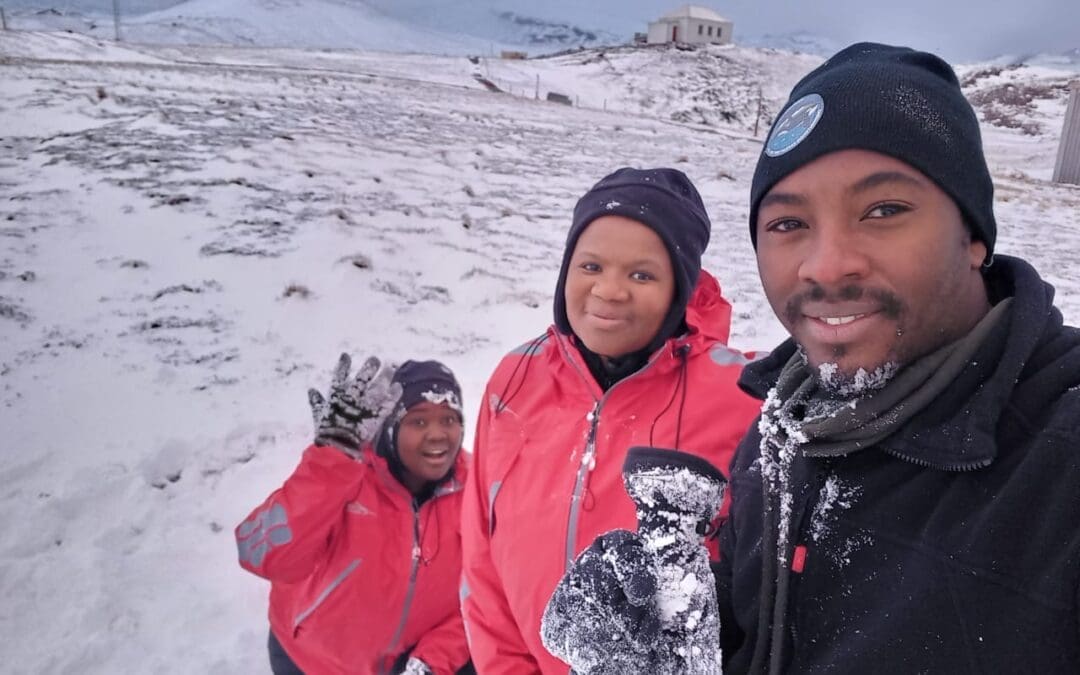
 Marion 78, our Overwintering team members at Marion Island celebrate Spring 2021. (Above(l-r: Alicia Siyasanga, Tlhonolofatso)
Marion 78, our Overwintering team members at Marion Island celebrate Spring 2021. (Above(l-r: Alicia Siyasanga, Tlhonolofatso)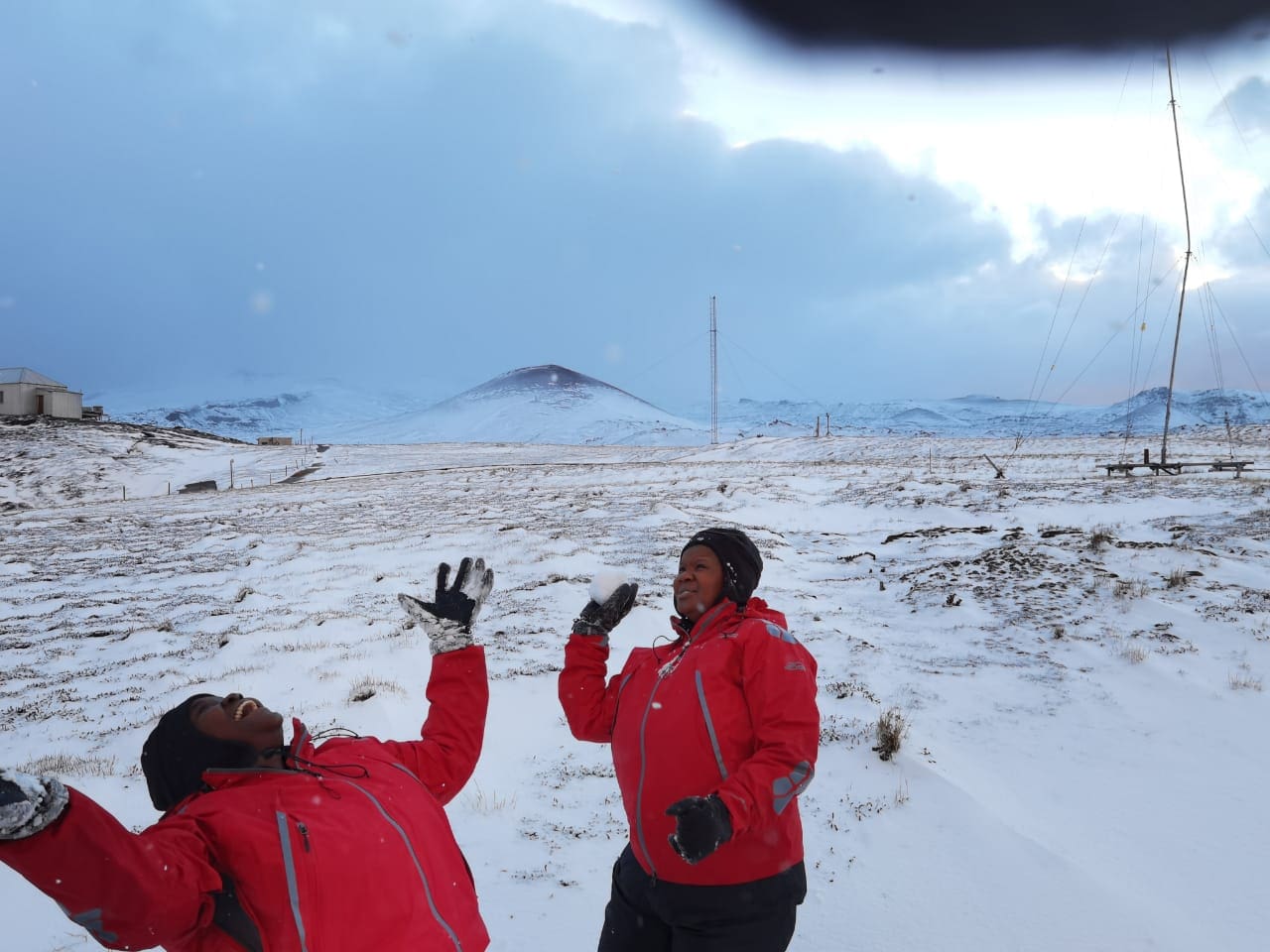
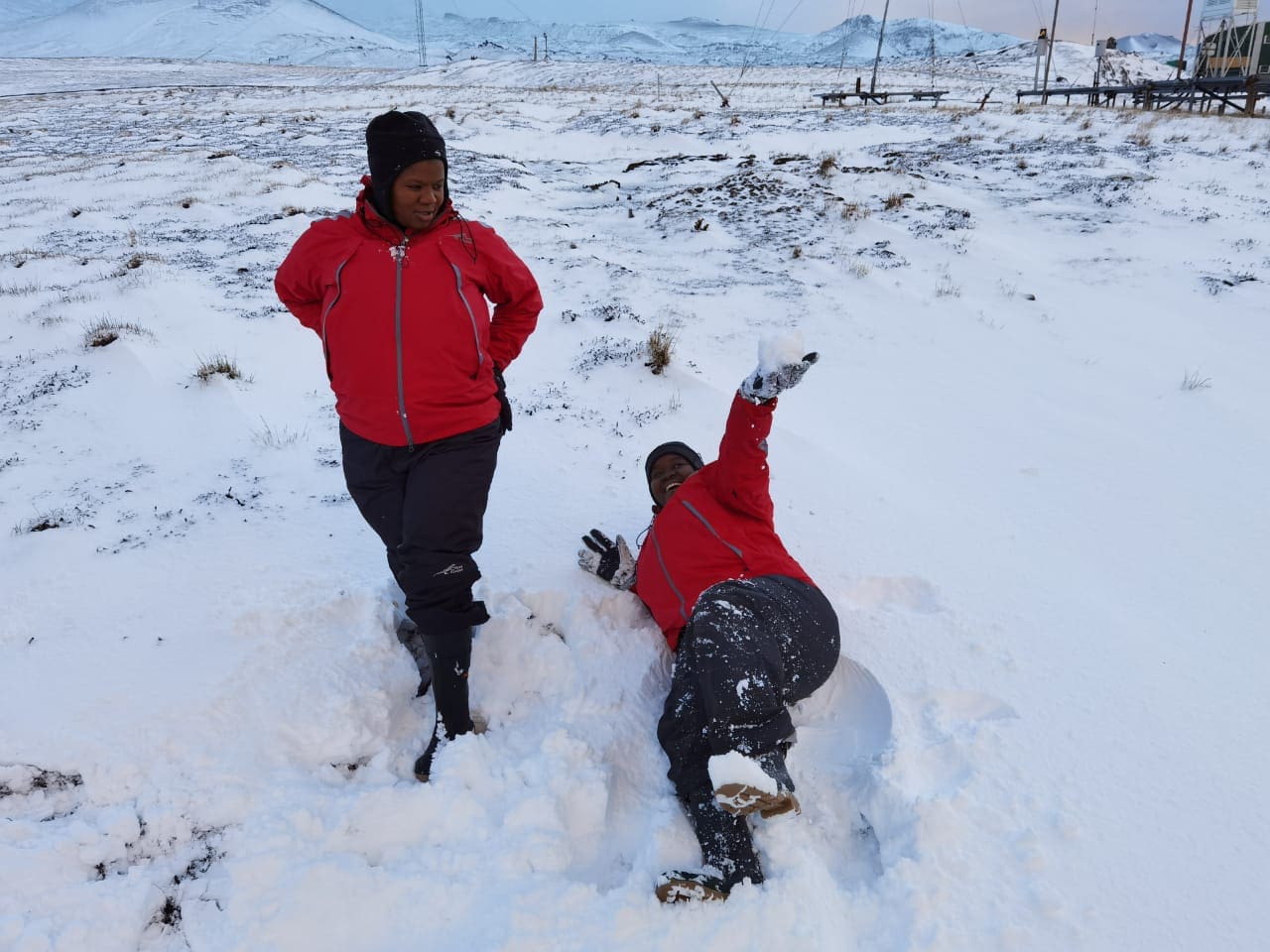
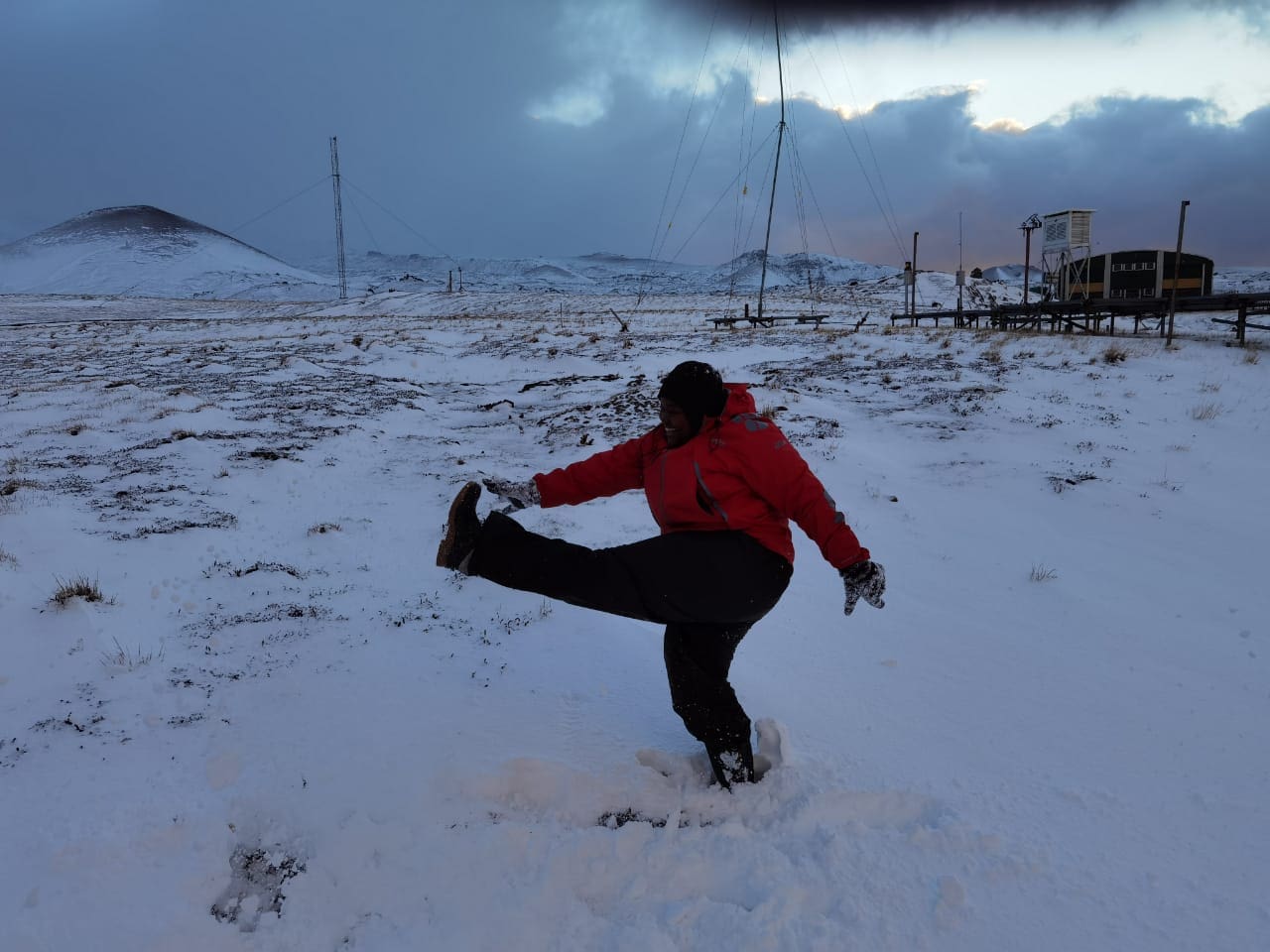
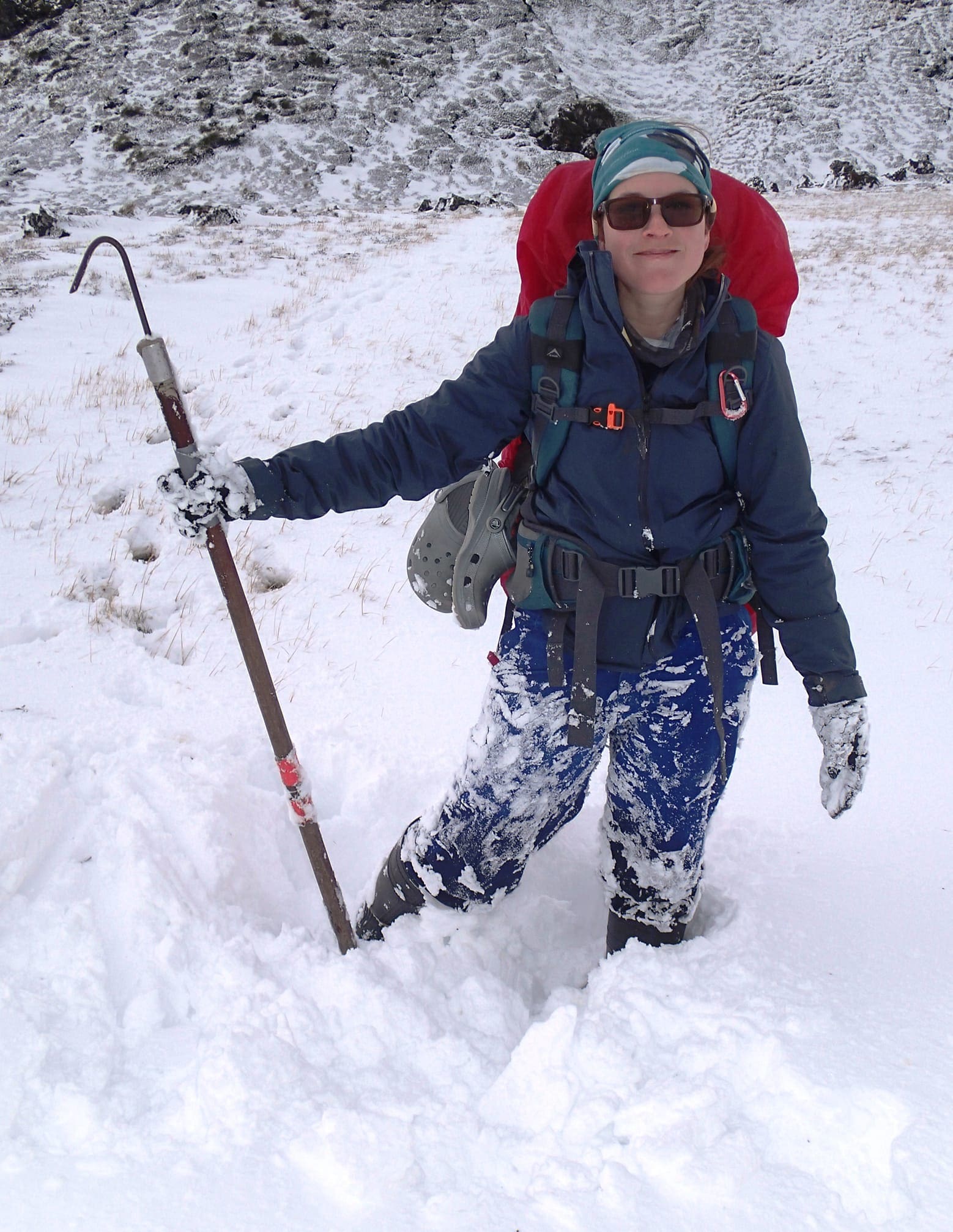 Danielle Conri, field assistant on killer whales of the Marion Island Marine Mammal Program of Pretoria University celebrates spring day while crossing though Marion Island to sensus seals (photo credit Wild Ocean Wanderers)
Danielle Conri, field assistant on killer whales of the Marion Island Marine Mammal Program of Pretoria University celebrates spring day while crossing though Marion Island to sensus seals (photo credit Wild Ocean Wanderers)
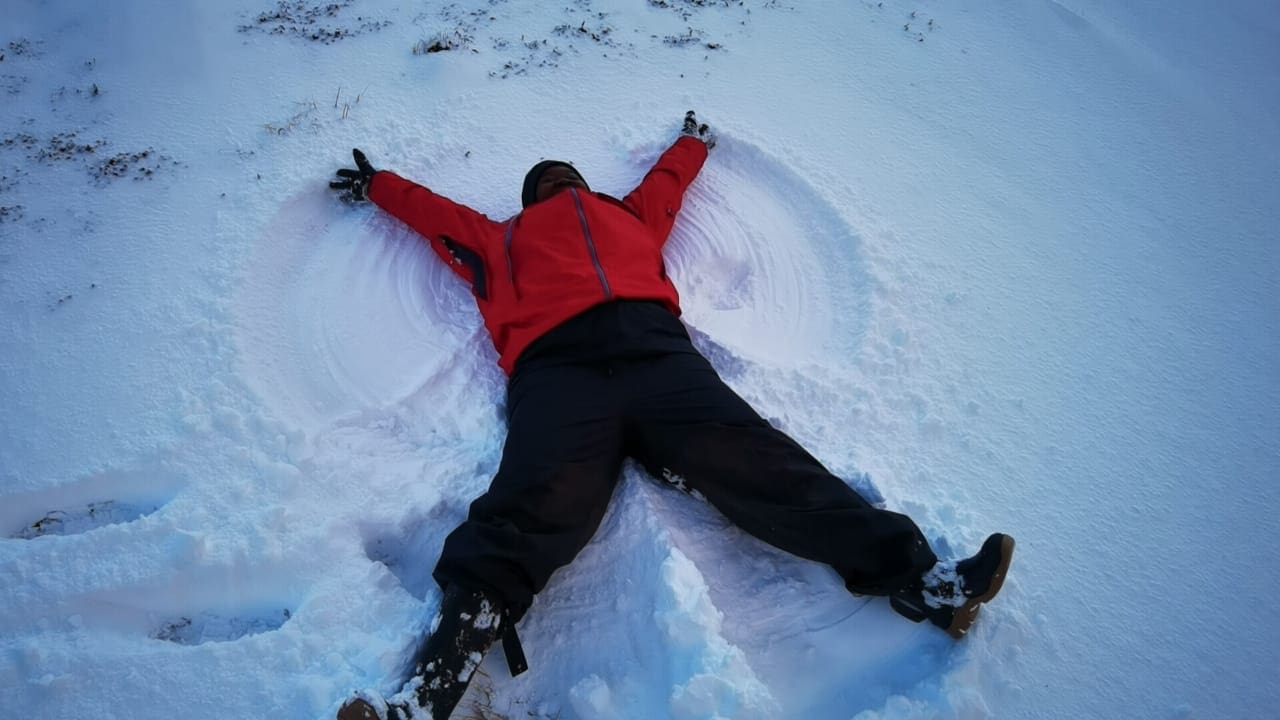 Always good to make a snow angel.
Always good to make a snow angel.

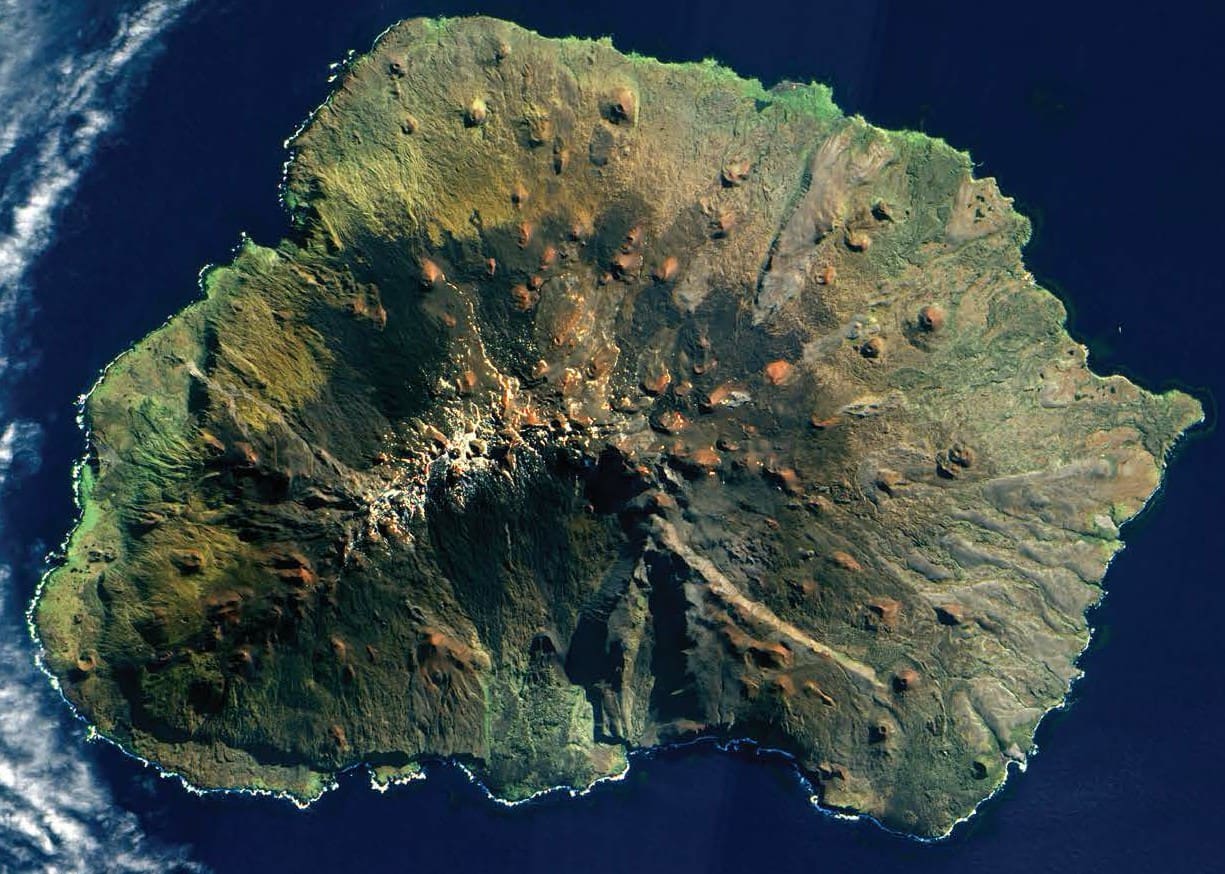
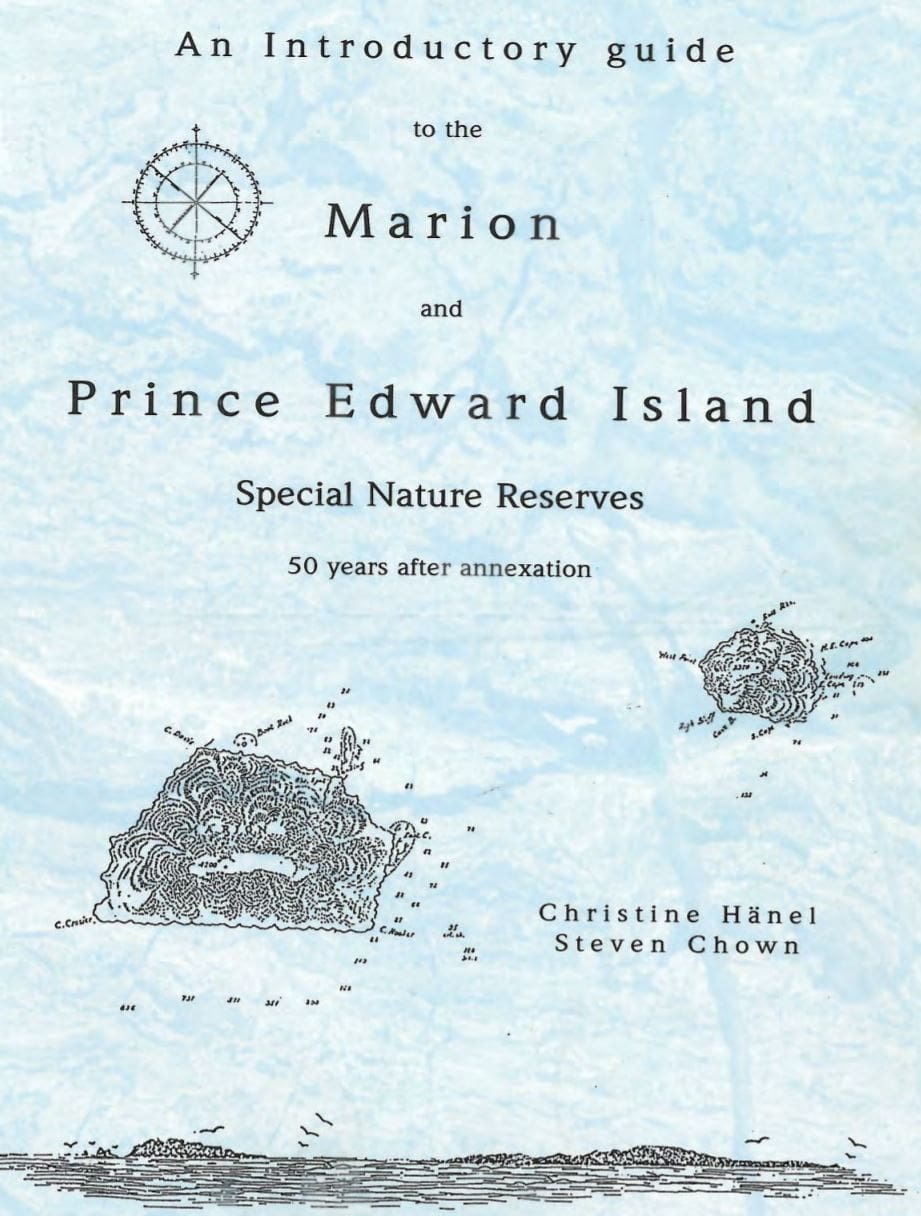 This is particularly obvious in the Southern Ocean where a warmer and dryer environment allows the proliferation of species once limited by the cold climate. South African
This is particularly obvious in the Southern Ocean where a warmer and dryer environment allows the proliferation of species once limited by the cold climate. South African 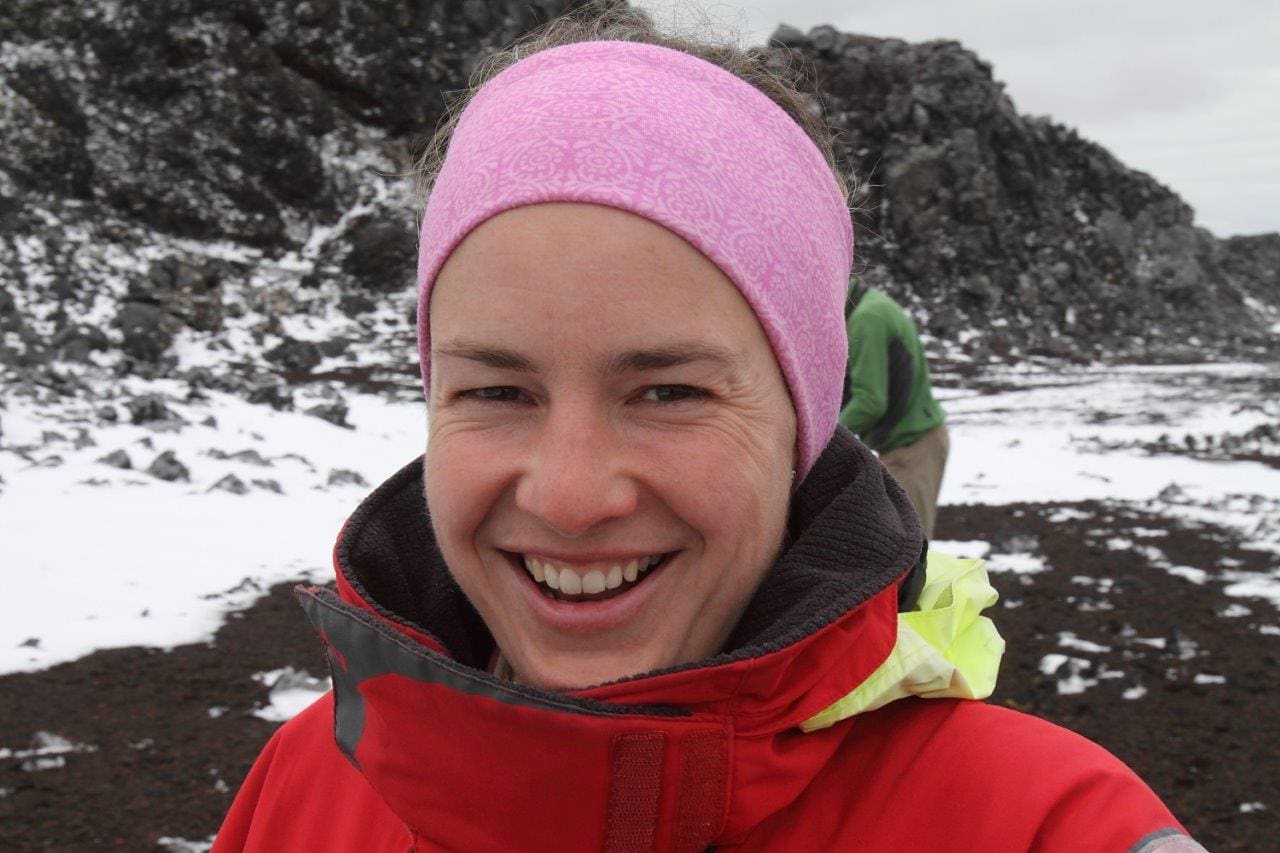
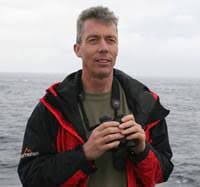 For the next three years, the new SANAP project co-led by Dr Maëlle Connan (Research Fellow in the
For the next three years, the new SANAP project co-led by Dr Maëlle Connan (Research Fellow in the 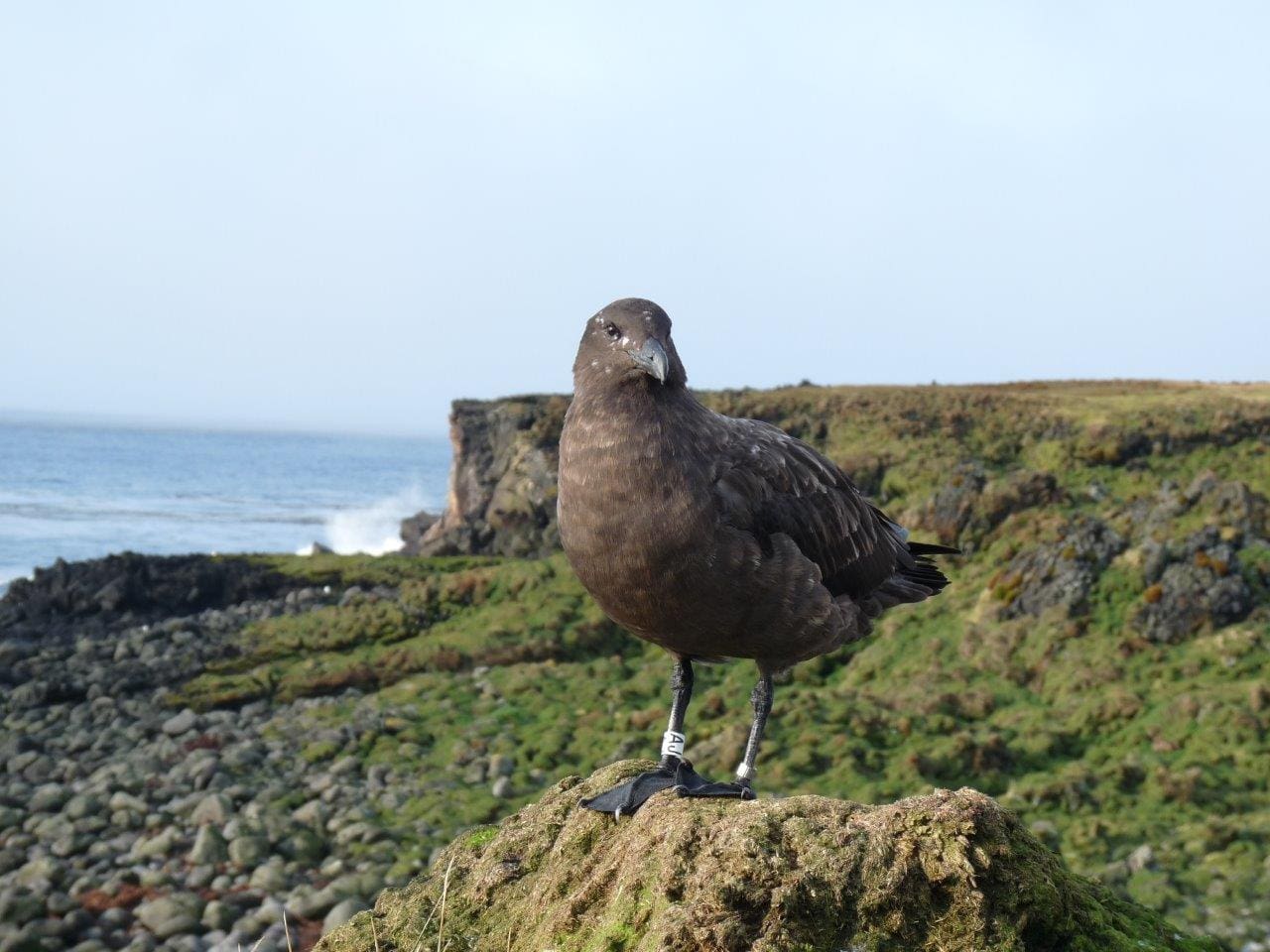
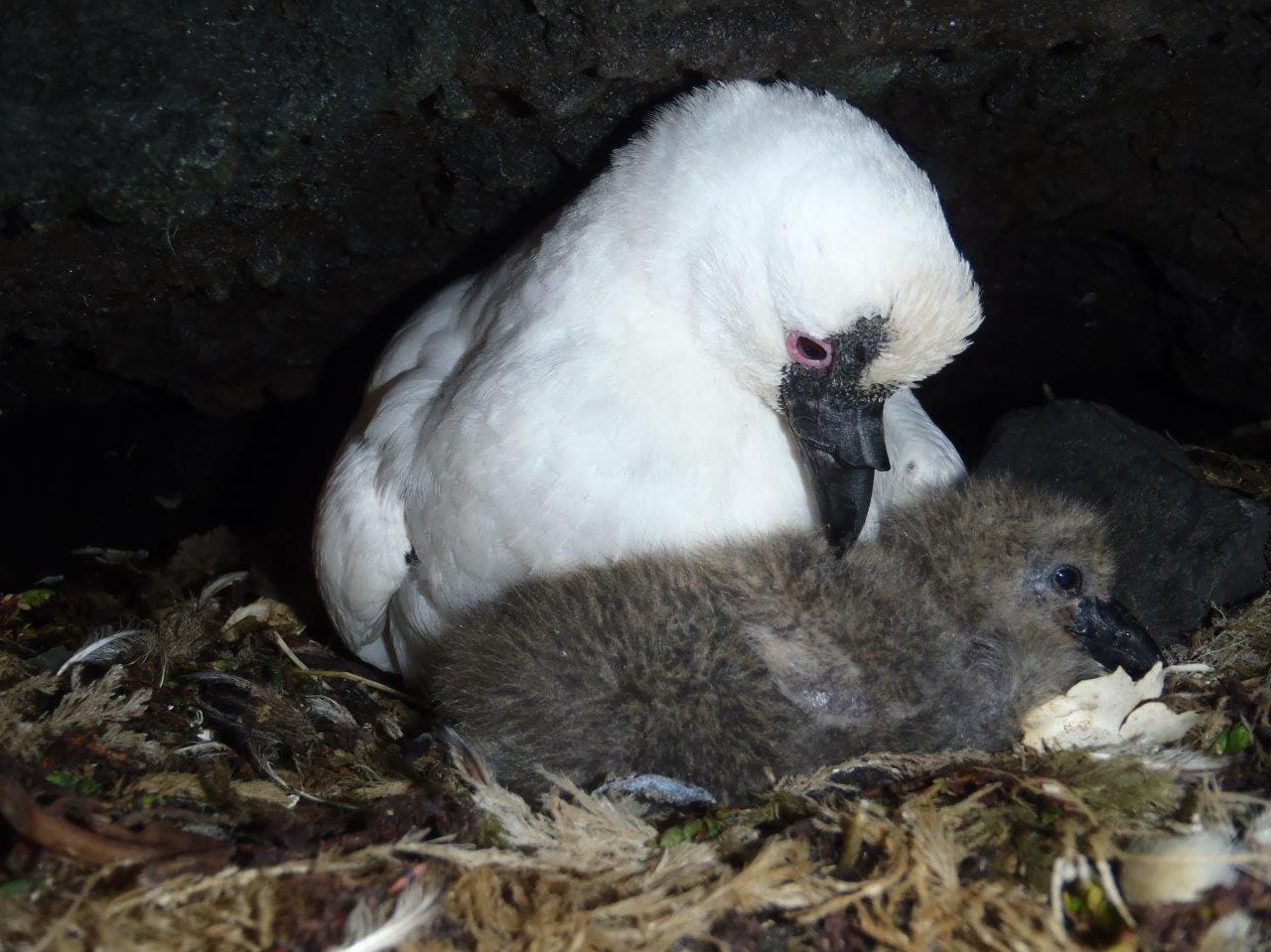 (Above l-r: Sub-Antarctic Skua, Black-Faced Sheathbill)
(Above l-r: Sub-Antarctic Skua, Black-Faced Sheathbill)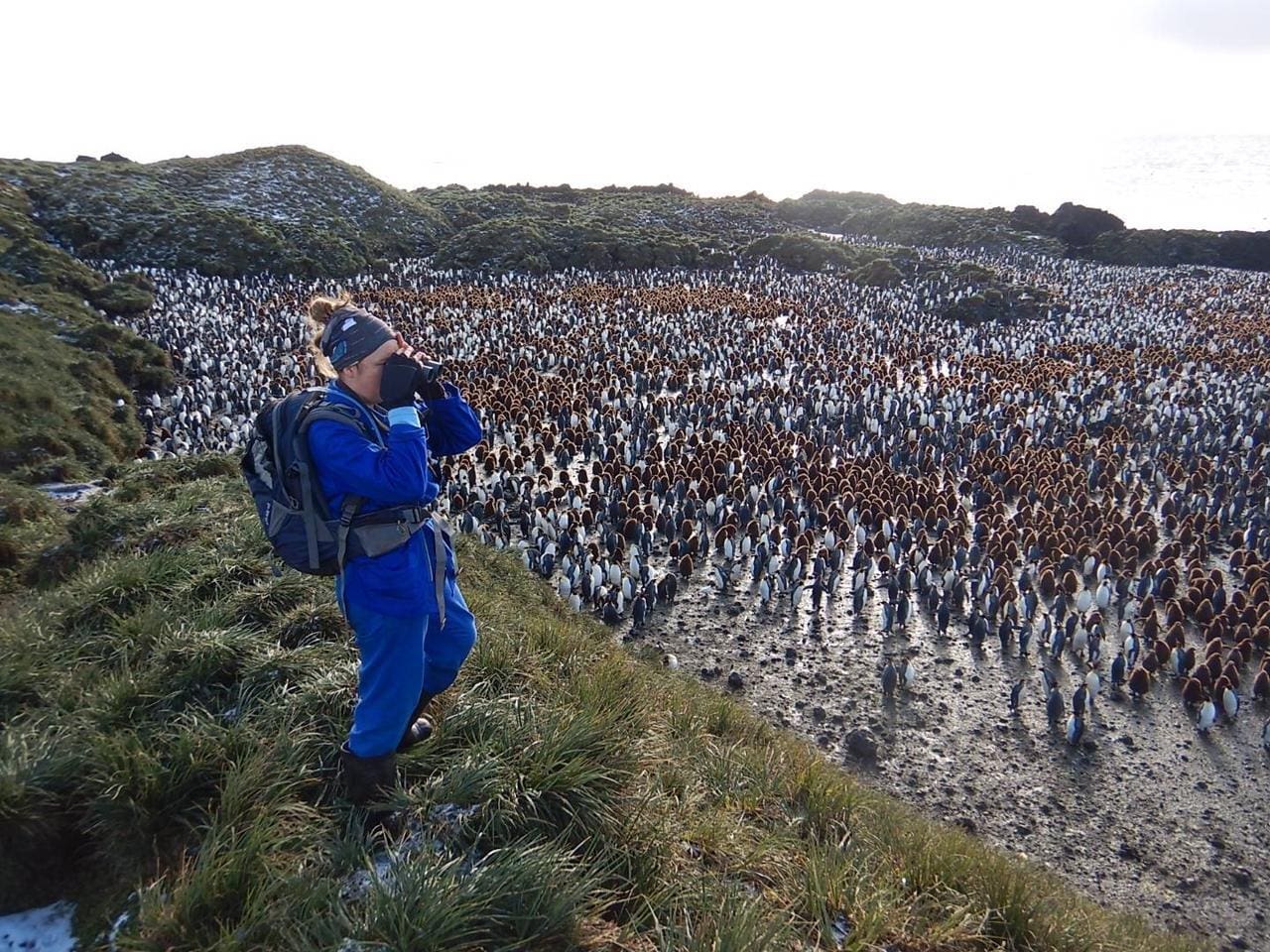
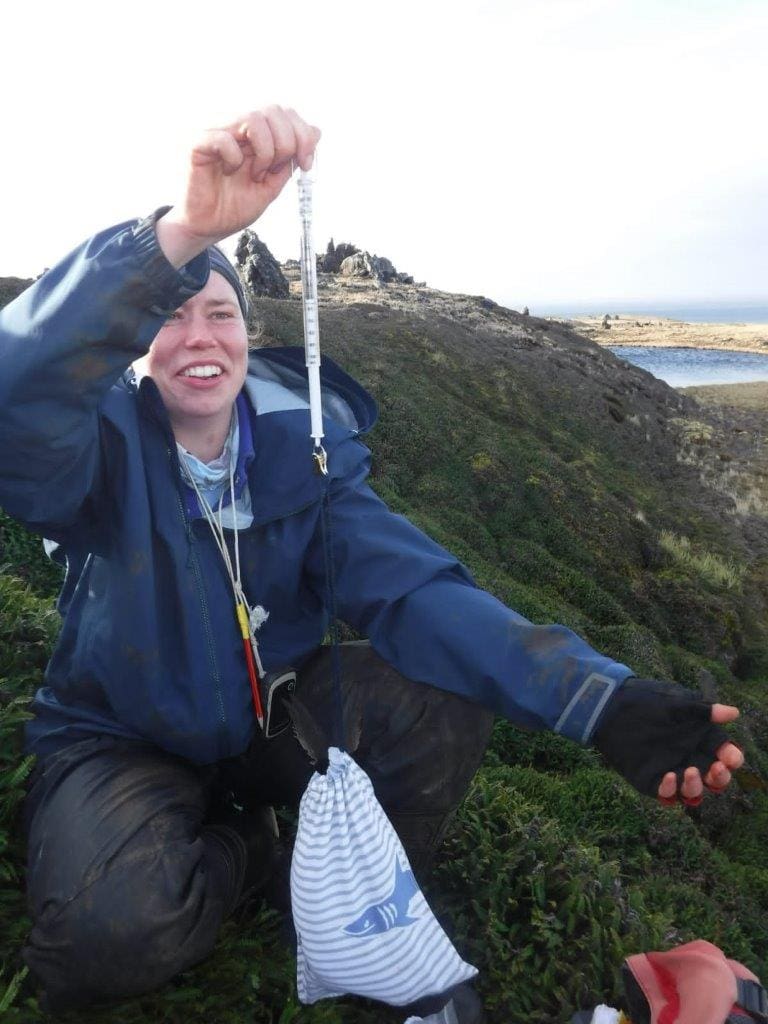 On one hand, Black-faced Sheathbills and Kelp Gulls used to predate on terrestrial invertebrates, at least seasonally, but this behaviour has decreased in sheathbills as invertebrate populations have collapsed through mouse predation. There are no recent data for Kelp Gulls. On the other hand, many pairs of Brown Skuas predate mainly on burrowing petrels, thus will inform on the recovery of these nocturnal species from mouse predation. The skua data will be complemented by the implementation of an automated acoustic monitoring to detect the presence and coarse distribution of the most elusive and cryptic nocturnal species which are notoriously difficult to study. (Left – Eleanor Weideman in the field on Marion Island.)
On one hand, Black-faced Sheathbills and Kelp Gulls used to predate on terrestrial invertebrates, at least seasonally, but this behaviour has decreased in sheathbills as invertebrate populations have collapsed through mouse predation. There are no recent data for Kelp Gulls. On the other hand, many pairs of Brown Skuas predate mainly on burrowing petrels, thus will inform on the recovery of these nocturnal species from mouse predation. The skua data will be complemented by the implementation of an automated acoustic monitoring to detect the presence and coarse distribution of the most elusive and cryptic nocturnal species which are notoriously difficult to study. (Left – Eleanor Weideman in the field on Marion Island.) Cover Image: Sub-Antarctic Skua – photo credit: Maelle Connan
Cover Image: Sub-Antarctic Skua – photo credit: Maelle Connan


 (Above left to right: temperature-depth profiles with time data of artificially grown sea ice, crystal structure of artificially grown sea ice, comparison of the Elastic Modulus of different types of sea ice)
(Above left to right: temperature-depth profiles with time data of artificially grown sea ice, crystal structure of artificially grown sea ice, comparison of the Elastic Modulus of different types of sea ice) (Above: left picture (UCT MARiS Mobile polar lab), Middle picture (Miss B. Matlakala and Mr F. Guni doing artificial sea ice experiments), Right Picture (Compression machine for testing mechanical properties of sea ice).
(Above: left picture (UCT MARiS Mobile polar lab), Middle picture (Miss B. Matlakala and Mr F. Guni doing artificial sea ice experiments), Right Picture (Compression machine for testing mechanical properties of sea ice).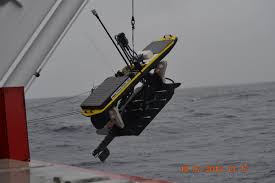 (Above left to right: Dr Tokoloho Rampai and A/Prof Marcello Vichi) Dr Tokoloho Rampai (chemical engineering department) is the principal investigator on the project, with the co-investigator A/Prof Marcello Vichi from the department of Oceanography.
(Above left to right: Dr Tokoloho Rampai and A/Prof Marcello Vichi) Dr Tokoloho Rampai (chemical engineering department) is the principal investigator on the project, with the co-investigator A/Prof Marcello Vichi from the department of Oceanography.

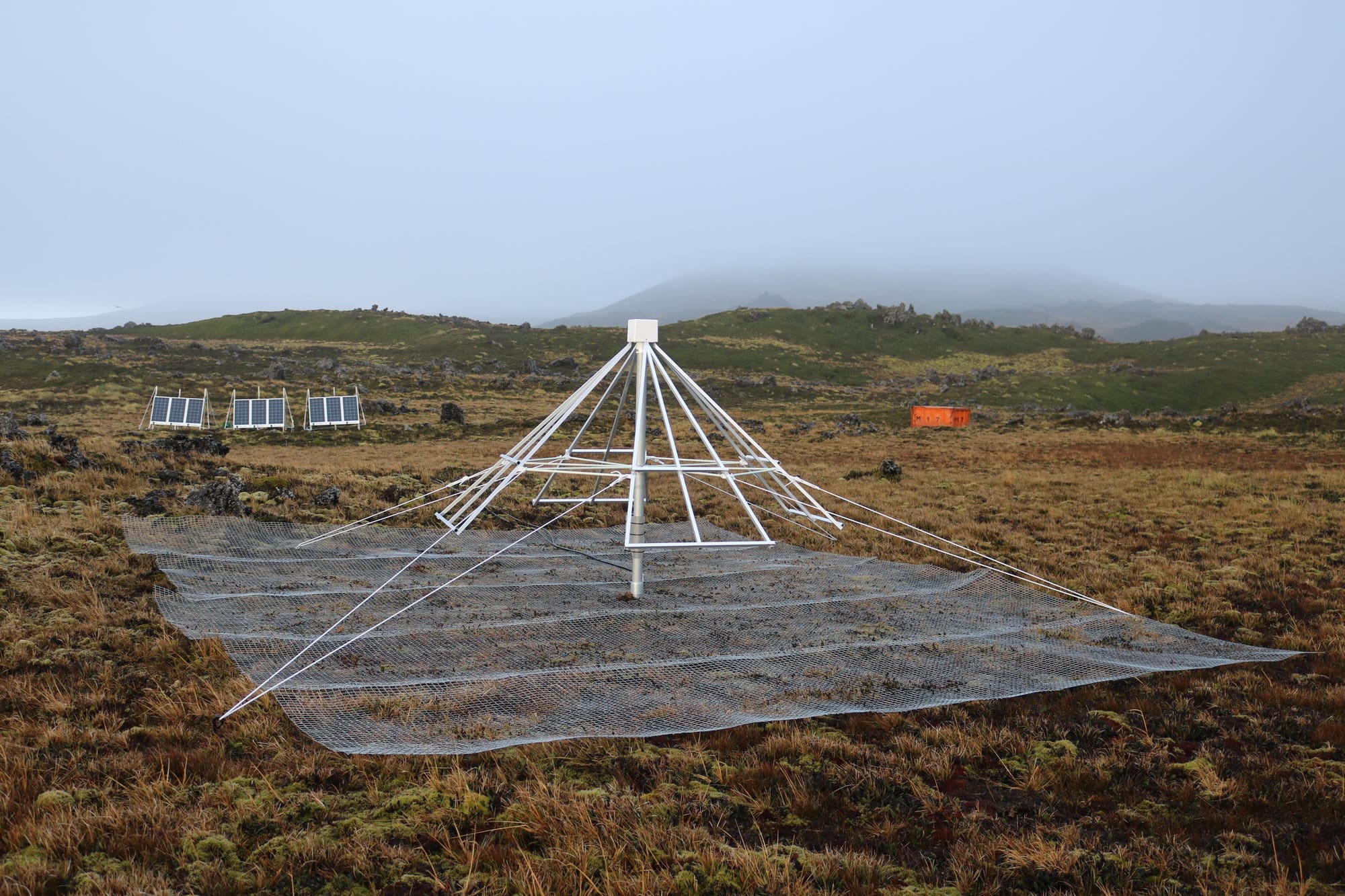

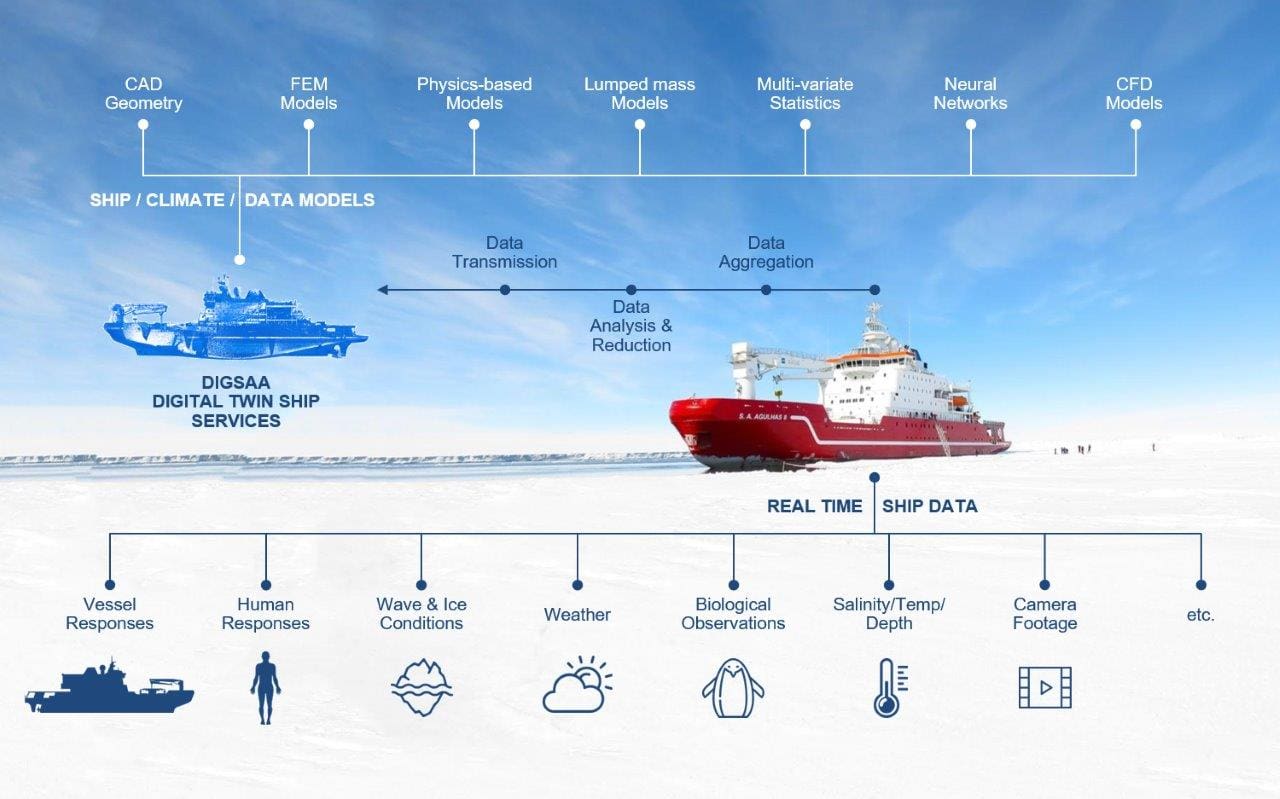 Industry 4.0 is the digital transformation of global industry. Digital twins pose to disrupt conventional business as they harness real-time data alongside a digitized representation of the state and behaviour of real assets to offer decision support. Sound and vibration research often entails multi-sensor measurements, signal processing and analytics providing an ideal training background to embrace the current innovation climate.
Industry 4.0 is the digital transformation of global industry. Digital twins pose to disrupt conventional business as they harness real-time data alongside a digitized representation of the state and behaviour of real assets to offer decision support. Sound and vibration research often entails multi-sensor measurements, signal processing and analytics providing an ideal training background to embrace the current innovation climate. Funding from the South African National Antarctic Programme, has boosted the group’s research to instigate the digital transformation of Africa’s only polar research vessel, the SA Agulhas II, to a “flagship for Vessel 4.0”. The full-scale measurement project – engineering measurements on the ship in operation – kicked off in 2012. SVRG collaborated in an international consortium including the Universities of Aalto and Oulo, Aker Arctic, Det Norske Veritas, Rolls Royce, Wärtsilä and STX Europe. The then, newly commissioned SA Agulhas II was put to the test during two days of ice-breaking operations in the Bay of Bothnia in Finland during ice-trails. Today, the SA Agulhas II is equipped with +200 engineering sensors to measure the ice and waves in the ship’s environment, the bending and twisting of her hull and the wellbeing of passengers.
Funding from the South African National Antarctic Programme, has boosted the group’s research to instigate the digital transformation of Africa’s only polar research vessel, the SA Agulhas II, to a “flagship for Vessel 4.0”. The full-scale measurement project – engineering measurements on the ship in operation – kicked off in 2012. SVRG collaborated in an international consortium including the Universities of Aalto and Oulo, Aker Arctic, Det Norske Veritas, Rolls Royce, Wärtsilä and STX Europe. The then, newly commissioned SA Agulhas II was put to the test during two days of ice-breaking operations in the Bay of Bothnia in Finland during ice-trails. Today, the SA Agulhas II is equipped with +200 engineering sensors to measure the ice and waves in the ship’s environment, the bending and twisting of her hull and the wellbeing of passengers.




